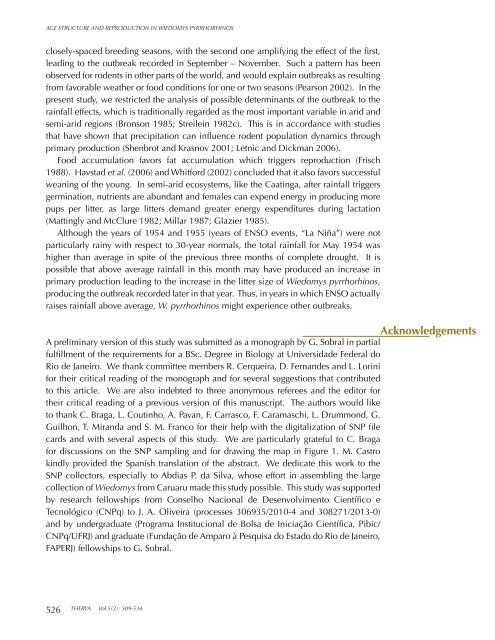therya-5_2
therya-5_2
therya-5_2
You also want an ePaper? Increase the reach of your titles
YUMPU automatically turns print PDFs into web optimized ePapers that Google loves.
AGE STRUCTURE AND REPRODUCTION IN WIEDOMYS PYRRHORHINOS<br />
closely-spaced breeding seasons, with the second one amplifying the effect of the first,<br />
leading to the outbreak recorded in September – November. Such a pattern has been<br />
observed for rodents in other parts of the world, and would explain outbreaks as resulting<br />
from favorable weather or food conditions for one or two seasons (Pearson 2002). In the<br />
present study, we restricted the analysis of possible determinants of the outbreak to the<br />
rainfall effects, which is traditionally regarded as the most important variable in arid and<br />
semi-arid regions (Bronson 1985; Streilein 1982c). This is in accordance with studies<br />
that have shown that precipitation can influence rodent population dynamics through<br />
primary production (Shenbrot and Krasnov 2001; Letnic and Dickman 2006).<br />
Food accumulation favors fat accumulation which triggers reproduction (Frisch<br />
1988). Havstad et al. (2006) and Whitford (2002) concluded that it also favors successful<br />
weaning of the young. In semi-arid ecosystems, like the Caatinga, after rainfall triggers<br />
germination, nutrients are abundant and females can expend energy in producing more<br />
pups per litter, as large litters demand greater energy expenditures during lactation<br />
(Mattingly and McClure 1982; Millar 1987; Glazier 1985).<br />
Although the years of 1954 and 1955 (years of ENSO events, “La Niña”) were not<br />
particularly rainy with respect to 30-year normals, the total rainfall for May 1954 was<br />
higher than average in spite of the previous three months of complete drought. It is<br />
possible that above average rainfall in this month may have produced an increase in<br />
primary production leading to the increase in the litter size of Wiedomys pyrrhorhinos,<br />
producing the outbreak recorded later in that year. Thus, in years in which ENSO actually<br />
raises rainfall above average, W. pyrrhorhinos might experience other outbreaks.<br />
Acknowledgements<br />
A preliminary version of this study was submitted as a monograph by G. Sobral in partial<br />
fulfillment of the requirements for a BSc. Degree in Biology at Universidade Federal do<br />
Rio de Janeiro. We thank committee members R. Cerqueira, D. Fernandes and L. Lorini<br />
for their critical reading of the monograph and for several suggestions that contributed<br />
to this article. We are also indebted to three anonymous referees and the editor for<br />
their critical reading of a previous version of this manuscript. The authors would like<br />
to thank C. Braga, L. Coutinho, A. Pavan, F. Carrasco, F. Caramaschi, L. Drummond, G.<br />
Guilhon, T. Miranda and S. M. Franco for their help with the digitalization of SNP file<br />
cards and with several aspects of this study. We are particularly grateful to C. Braga<br />
for discussions on the SNP sampling and for drawing the map in Figure 1. M. Castro<br />
kindly provided the Spanish translation of the abstract. We dedicate this work to the<br />
SNP collectors, especially to Abdias P. da Silva, whose effort in assembling the large<br />
collection of Wiedomys from Caruaru made this study possible. This study was supported<br />
by research fellowships from Conselho Nacional de Desenvolvimento Científico e<br />
Tecnológico (CNPq) to J. A. Oliveira (processes 306935/2010-4 and 308271/2013-0)<br />
and by undergraduate (Programa Institucional de Bolsa de Iniciação Científica, Pibic/<br />
CNPq/UFRJ) and graduate (Fundação de Amparo à Pesquisa do Estado do Rio de Janeiro,<br />
FAPERJ) fellowships to G. Sobral.<br />
526<br />
THERYA Vol.5(2): 509-534



